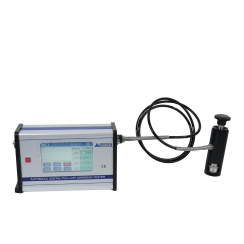Paint adhesion testing is crucial in ensuring that coatings, whether on vehicles, buildings, or industrial machinery, adhere properly to surfaces. One of the most reliable tools for this purpose is the paint adhesion tester, specifically the pull-off adhesion tester, which provides a quantitative way to evaluate adhesion strength. However, despite their utility, these tests can sometimes present challenges that may impact their reliability and effectiveness. Understanding these challenges is key to ensuring accurate results and improving coating performance.
Challenges in Paint Adhesion Testing
Paint adhesion testing, particularly with pull-off adhesion testers, is a critical component of quality control in industries that rely on durable and long-lasting coatings. While the process is designed to provide precise results, several factors can complicate the testing procedure and affect the outcomes. Below, we discuss five common challenges and ways to overcome them.
Surface Preparation and Contamination
Surface preparation is arguably the most significant factor that can impact the accuracy of paint adhesion testing. Even the smallest amount of contamination, whether from oils, dust, or moisture, can undermine the bond between the coating and the substrate. For instance, pull-off adhesion testers need a clean, even surface for the test to give accurate results. Any residue left on the surface will interfere with the tester’s ability to accurately measure the strength of the adhesion, potentially leading to false results.
To solve this problem, it’s important to follow a strict surface cleaning procedure before doing adhesion tests. Using solvents and abrasive methods to remove contaminants ensures that the substrate is as clean as possible. Additionally, testing in controlled environments can help reduce the risk of contamination, especially in industries where dust or moisture is prevalent.
Variability in Substrate Materials
The type of substrate being tested can also present challenges when using a pull-off adhesion tester. Different materials, such as metals, plastics, and wood, have distinct properties that affect how a coating adheres to them. For instance, a coating may bond more strongly to a steel surface than to a plastic one, leading to variability in test results. Substrate characteristics like roughness, porosity, and chemical composition can all influence adhesion strength, making it difficult to establish standardized test results across different materials.
To overcome this challenge, it’s essential to calibrate the adhesion tester to account for the specific type of substrate being tested. Manufacturers often provide guidelines on how to adjust test parameters based on the material, which can improve consistency. Additionally, understanding the interaction between coating and substrate properties will help operators interpret the test results more accurately.
Inconsistent Testing Conditions
Another significant challenge in paint adhesion testing arises from inconsistent environmental conditions. Factors such as temperature, humidity, and air pressure can all affect the results of a pull-off adhesion test. For instance, if the test is done in a very humid place, the coating might soak up water, which could make the adhesion strength weaker. Similarly, extreme temperatures can cause coatings to expand or contract, leading to inconsistent results.
To mitigate this, it’s essential to conduct adhesion tests in a controlled environment where temperature and humidity are monitored and kept within specified limits. Using climate-controlled chambers or conducting tests in a lab setting can significantly reduce the influence of external variables and ensure more consistent, reliable results.
Equipment Calibration and Maintenance
The accuracy of pull-off adhesion testers depends on regular calibration and maintenance. Over time, the equipment may experience wear and tear, affecting its precision. If the tester isn’t calibrated correctly, it may produce inaccurate results, leading to erroneous conclusions about the performance of the coating. Regular calibration, as well as routine checks for any signs of malfunction or degradation, are crucial in maintaining the reliability of the testing process.
Paint adhesion tester manufacturers recommend a strict calibration schedule to maintain consistent results over time. Additionally, routine maintenance, such as cleaning components and inspecting for wear, helps identify issues early on and prevents costly errors in testing.
Operator Skill and Interpretation
Finally, one of the most common challenges in paint adhesion testing is the skill and experience of the operator. Despite the precision of pull-off adhesion testers, human error can still play a role in inaccurate results. Inexperienced operators may misinterpret readings, use improper testing techniques, or fail to follow best practices, which can compromise the validity of the test.
To reduce the impact of operator errors, it’s essential to provide proper training for all personnel involved in the testing process. This includes understanding how to set up the equipment, conduct tests, and interpret results accurately. Advanced training can help operators identify potential issues during testing and ensure the reliability of the results.
Conclusion
Despite these challenges, paint adhesion testing remains a vital tool for quality assurance in various industries. By addressing issues like surface preparation, substrate variability, environmental consistency, equipment maintenance, and operator skill, manufacturers can improve the reliability of their adhesion tests. Utilizing pull-off adhesion testers, in particular, offers an effective and standardized way to measure coating strength. However, maintaining proper procedures and equipment ensures that the results reflect the true performance of the coating, leading to better products and more satisfied customers.





